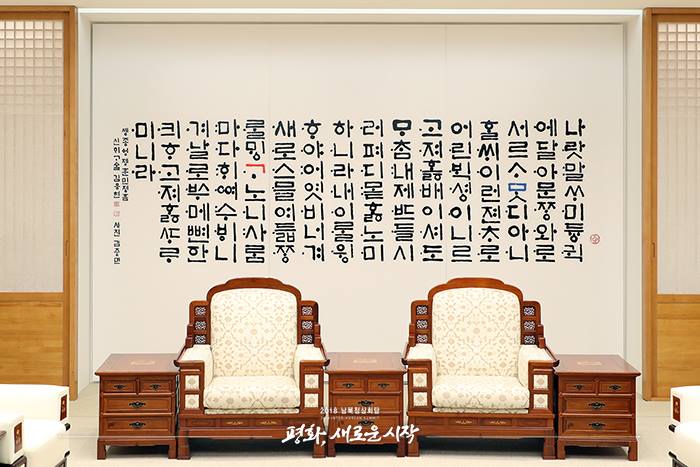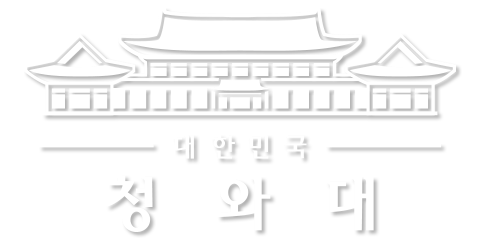이 웹사이트는 제19대 대통령 임기 종료에 따라 대통령기록관이 「대통령기록물 관리에 관한 법률」에 의해 이관받아 서비스하는 대통령기록물입니다. 자료의 열람만 가능하며 수정 · 추가 · 삭제는 불가능합니다.
다만, 「개인정보보호법」에 의하여 개인의 정보를 보호받기 원하시는 분은 관련 내용(요청자, 요청내용, 연락처, 글위치)을 대통령 웹기록물 담당자(044-211-2253)에게 요청해 주시면 신속히 검토하여 조치해 드리겠습니다. 감사합니다.
SPEECHES & REMARKS
BRIEFINGS
Vice Presidential Spokesperson Ko Min-jung Briefs Media on Renovation of Peace House

The theme of Welcome, Thoughtfulness, Peace and Hope has been embodied in the process. In this connection, each piece of furniture and artwork was chosen very carefully to convey their own stories.
The interior of the summit venue has been spruced up as follows.
The first-floor reception area embodies the spirit captured by the expression “a white-clad people,” one of the favorite names of Koreans for themselves. Decorations made of hanji, traditional Korean mulberry paper, and mosi, or ramie fabric, convey an unpretentious, unforced beauty and sense of warmth. Those who enter will feel like they are being welcomed into the main sitting room of a traditional Korean home, surrounded on all sides by hanji windows.
The second-floor conference hall is carpeted in blue, a color that represents aspirations for a brighter, more peaceful future. It brings to mind the sarangbang, the room in traditional Korean houses where guests are welcomed, as a comfortable setting for honest, open conversation.
The third-floor banquet hall, with white walls and a green carpet and curtain, evokes the freshness of a barley field in late spring and the two Koreas’ peaceful journey toward unity.
All the new furniture in the conference hall and on the other stories at Peace House were mainly made of walnut wood. Not being prone to bending and warping over time, the wood has been chosen to wish that inter-Korean relations would remain unwavering on the basis of mutual trust. It is also a material befitting the desire to preserve the venue of the historic inter-Korean summit as it is.
A table for the guestbook on the first floor is reminiscent of Haeju Soban, or a small portable table traditionally produced in Haeju, Hwanghaenam-do Province in North Korea. It is to express the sense of joy and welcome for the invited guests. The chair in front of the table was designed in the shape of Chinese characters meaning blessings in the hope there would be good fortune for the Korean Peninsula.
The summit table on the second floor, where the two leaders will discuss major issues, is 2018 mm in diameter, symbolizing the year the historic summit is being held. The table top is oval, a departure from the usual, rigid rectangular shape, to help bridge the psychological distance stemming from the physical boundary marked by the Military Demarcation Line and 65 years of division. It is also intended to promote candid, heart-to-heart discussions among officials from both sides sitting around the oval table.
There is a sofa for the two leaders to sit on during the summit, which is emblazoned with a design of the Korean Unification Flag.
Peace House had previously been used for inter-Korean meetings between minister-level officials, thus did not have furniture deemed appropriate for a summit. Only the absolutely necessary furniture has been added in order to save the Government budget. Some of the furniture came from Cheong Wa Dae or other government organizations after being repaired.
Following is an explanation of the major artworks that grace the venue and why they have been chosen. The underlying theme is also “Welcome, Thoughtfulness, Peace and Hope.”
Bukhansan Mountain, a painting by Min Joung-ki, was placed on the back wall of the lobby, which will be used as the background for commemorative photos during the summit. The painting depicts Bukhansan, a rocky mountain in the northern part of Seoul. It is meant to invite the first North Korean leader visiting the South to a famous mountain in the capital. Though it is located in Seoul, the name of Bukhansan literally means a “North Korean” mountain, and its dual meaning was taken into consideration.
Fog on the Mountain, a woodblock print by Kim Joon-kwon, was placed as the background for the guestbook table. The image of a mountain with deep shadows created with Indian ink will become a background for a person standing in front of the table, which creates an overall stable composition. This will look as if a South Korean mountain welcomes the North Korean leader in a respectable and comfortable manner.
A screen in the reception room on the first floor is made up of a photograph of a work of calligraphy owned by the King Sejong Great Memorial Hall. The photograph is titled Companion for One Thousand Years, the Beginning. It depicts the calligraphy of Kim Eung-hyun (Yeocho,1927-2007) of a text from the book Hunminjeongeum (Correct Sounds for Instructing the People, or hangeul, Korean characters) which is shared by both South and North Korea and is meant to stress that the two Koreas consist of one people. In his photograph, Kim Jung-man highlighted the first letter of the family name of the two leaders in blue and red in the hope that they have good enough chemistry to make the Korean Peninsula a land of peace.
Geumgangsan Mountain seen from Sangpaldam Ponds, a painting by Shin Jang-sik, is on display at the back of the meeting room on the second floor. The painting of Geumgangsan Mountain, the symbol of reconciliation and cooperation between the two Koreas, was brought into the venue of the summit to wish for its success.
On both sides of the wall at the entrance of the meeting room are paintings by Lee Suk-ja, Green Barley & Yellow Rape Blossoms and Green Barley & Purple Thistle. These artworks depict the scenery of the barley fields of the Korean Peninsula during the period from the end of April to early May. The green barley in these two artworks symbolize the tenacious vitality of the Korean people.
Behind the seat of the guest of honor at the banquet hall on the third floor is a painting by Shin Tae-su, Jangsan Point from Dumujin. This artwork was chosen to exhibit the Yellow Sea as a symbol of peace instead of conflict. It is where Baengnyeongdo Island is located, the frontline facing North Korea.
The flower vases used for the conference are Moon Jars (large round white porcelain vases), which express the beauty of Korea and convey the meaning of prosperity. The flowers will include bright-colored peonies, which are called the “king of flowers,” redbuds, which symbolize friendship, daisies, which epitomize peace, and wildflowers from the DMZ as well as rape blossoms from Jejudo Island. These are meant to show spring on the Korean Peninsula, which has overcome the bleak and cold winter.
These symbolic spaces have been designed to quietly speak to the leaders of the two Koreas as they come together during this historic event. We have made meticulous preparations in all aspects to achieve the successful hosting of the 2018 Inter-Korean Summit. We look forward to a great interest and full support of the Korean people.



